Rocket Balls: Conserving Energy But Creating Fun
Will a ball bounce higher than it was dropped? You might say no, but come take a journey and allow a bug to tell you otherwise.
What you Need
- Basketball
- Tennis ball
What to Do
You are about to recreate history and defy your intuition about the laws of bouncing balls!

Take the basket ball and the tennis ball and bounce each of them separately on a hard surface. Try bouncing them on a cookie sheet for fantastic sound effects! Listen carefully to the distinct sounds of each ball as it bounces. Your ears will play a more important roll than your eyes in this experiment. Now hold the basketball in one hand and the tennis ball in the other so that they are poised at the same height above the ground. Examine each of them as you raise them high above your head. Contemplate their weight and size. Ask gravity which ball it will pull down first. Will it be the heavy basketball or the small tennis ball? Listen to gravity and form a hypothesis.

Drum roll please. With great dexterity, release both balls at the same time. Watch and more importantly, listen. Did you observe which ball was gravity’s favorite?
The most important part of an observation is repeatability. An experiment is rarely perfect on the first try. In fact, it is never perfect. There is always some experimental error. Drop the balls several times and form a conclusion based on the average of your results.
After observing the balls drop several times, you may notice that they never bounce as high as their starting position. Why is this? And can you manage to bounce them higher than their initial height without throwing them down? Perhaps if they worked together…
Now it is time to take this experiment outside or into a gym. Place the tennis ball on top of the basketball and gently release them together!
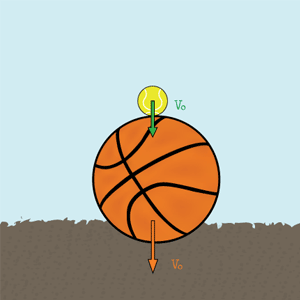
What’s Going On?
To see what happened in this super extraordinary bounce, we will need to take a journey and put ourselves in the shoes of a bug living on the basketball. (Since when do bugs wear shoes and live on basketballs? Since we started using our imagination!) From the perspective of the bug on the basketball, we fall and then bounce off the ground. Our velocity at impact is roughly 10mph. Due to the Law of Conservation of Energy the basketball bounces up from the ground at about the same velocity as it hit the ground. (The bounce actually releases energy in the form of sound and heat. This causes the ball to bounce up negligibly slower than it impacted the ground.)
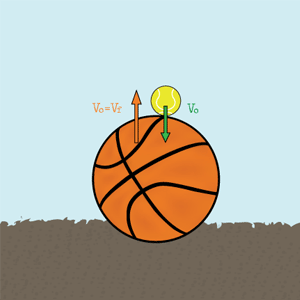
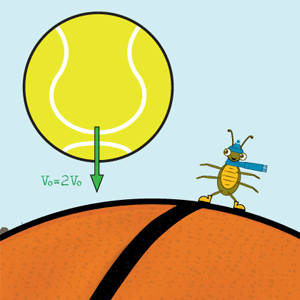
And from the bug’s point of view, we bounce up at about the same velocity of 10mph. At this moment, we see the tennis ball coming down upon us like a giant meteor. We brace ourselves for the impact and pause to think about how fast the tennis ball is speeding toward us. The tennis ball was falling with us the whole time at the same rate. Then we bounced first with a velocity of about 10 mph. Now this means that we are moving up from the ground at 10mph while the tennis ball is still falling down toward the ground at 10 mph. Here comes the slightly tricky part (but not really). From the bug’s perspective on the basketball, we collide with the tennis ball at 20 mph that is our up velocity plus the tennis ball’s downward velocity.
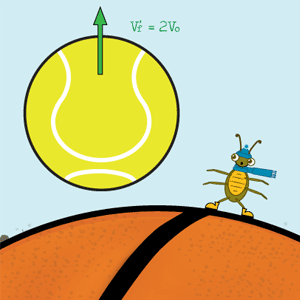
Chew on that thought for a moment and it will soon become clear. The physics of changing perspectives can be confusing. In fact, it’s call relativity. Take your time. There is no need to rush. We will wait…

Welcome back. Now as we collide with the tennis ball, energy is once again conserved. This means that the tennis ball will bounce up and away from the basketball at the same velocity as during the impact (roughly 20 mph).
Let’s jump back into our own shoes on the ground and conclude our observations. The basketball bounced up with some velocity (roughly 10 mph). At the same moment, the tennis ball bounced away from the basketball at twice that speed. Now putting this together, we see that the tennis ball is flying up way from the basketball at 20 mph plus the velocity of the basketball that it bounced off. This brings us to the conclusion that the tennis ball flies up into the air at 30 mph which is three times the velocity at which it fell to the ground!
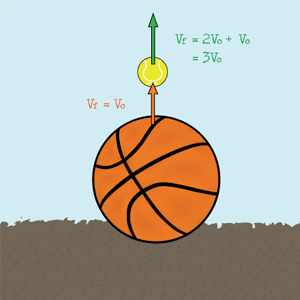
But why so high? It turns out that since the tennis ball flies up three times faster than it would without the basketball, that velocity translates into a lot of kinetic energy. As the tennis ball flies up into the air, gravity slows it down, converting all of that kinetic energy into potential energy. And the more potential energy the ball, the higher it will go.
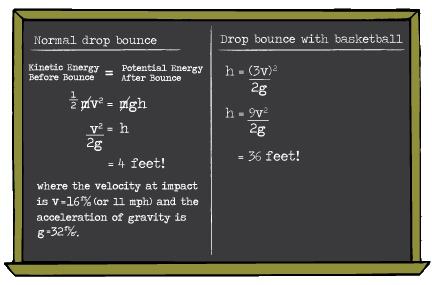
In the case of our current experiment, the tennis ball will fly up to 9 times higher than it would without the help of the basketball.
See if you can best this value!
Try This!
Now to switch things up, you should try placing the basketball on top of the tennis ball. Will the basketball bounce higher?
Try adding a third ball like a ping pong ball on top of the tennis ball. Can you figure out how fast the ping pong ball will fly up into the air?
More Information











